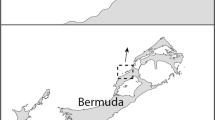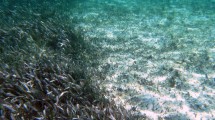Abstract
Before populations of green turtles (Chelonia mydas) were severely reduced by human overexploitation, the seagrass Thalassia testudinum was intensively grazed by green turtles in the Caribbean. To explore how nutrient composition of T. testudinum pastures responds to intense grazing pressure, we simulated green turtle grazing in 15 plots (each 3 m × 3 m) for 16 months in the central Bahamas. Comparisons of clipped plots with 15 adjacent control (unclipped) plots revealed that simulated grazing resulted in significantly higher energy, nitrogen, phosphorus, lignin, cutin, and condensed tannin content in blades in clipped plots, but sediment organic content was not affected. By continually re-cropping blades in grazing plots, turtles ingest young, actively growing blade tissue with higher energy, nitrogen, and phosphorus concentrations. Our 16-month clipping trial did not generate the expected decline in nutrient content in T. testudinum blades under intensive grazing. However, significant decreases in nitrogen and organic matter reserves in rhizomes, with declines apparent after 16 and 11 months, respectively, indicate that nutrient content of blades and/or blade productivity may decline under continued clipping.

Similar content being viewed by others
References
Ankom Technology Company (1998) Method for determining neutral detergent fiber (aNDF). Ankom Technical Manuals, Fairport
Ankom Technology Company (1999) Method for determining acid detergent fiber. Ankom Technical Manuals, Fairport
Arnold TM, Schultz JC (2002) Induced sink strength as a prerequisite for induced tannin biosynthesis in developing leaves of Populus. Oecologia 130:585–593
Arnold TM, Tanner CE, Hatch WI (1995) Phenotypic variation in polyphenolic content of the tropical brown alga Lobophora variegata as a function of nitrogen availability. Mar Ecol Prog Ser 123:177–183
Audubon MR (1897) Audubon and his journals, vol. 2. Books for Libraries Press, Freeport
Balazs GH, Fujioka R, Fujioka C (1993) Marine turtle faeces on Hawaiian beaches. Mar Pollut Bull 26:392–394
Bjorndal KA (1979) Cellulose digestion and volatile fatty acid production in the green turtle, Chelonia mydas. Comp Biochem Physiol 63A:127–133
Bjorndal KA (1980) Nutrition and grazing behavior of the green turtle, Chelonia mydas. Mar Biol 56:147–154
Bjorndal KA (1982) The consequences of herbivory for the life history pattern of the Caribbean green turtle. In: Bjorndal KA (ed) Biology and conservation of sea turtles. Smithsonian Institution Press, Washington, pp. 111–116
Bjorndal KA (1985) Nutritional ecology of sea turtles. Copeia 1985:736–751
Bjorndal KA (1997) Foraging ecology and nutrition of sea turtles. In: Lutz PL, Musick JA (eds) The biology of sea turtles. CRC, Boca Raton, pp. 199–231
Bjorndal KA, Bolten AB, Chaloupka MY (2000) Green turtle somatic growth model: evidence for density dependence. Ecol Appl 10:269–282
CARICOMP (1997a) Meteorological and oceanographic characterization of coral reef, seagrass and mangrove habitats in the Wider Caribbean. In: Lessios HA, MacIntyre IG (eds) Proceedings of the 8th international coral reef symposium, vol. 1. Smithsonian Tropical Research Institute, Balboa, Panama, pp. 657–662
CARICOMP (1997b) Variation in ecological parameters of Thalassia testudinum across the CARICOMP network. In: Lessios HA, MacIntyre IG (eds) Proceedings of the 8th international coral reef symposium, vol. 1. Smithsonian Tropical Research Institute, Balboa, Panama, pp. 663–668
Cipollini DF Jr (1997) Wind-induced mechanical stimulation increases pest resistance in common bean. Oecologia 111:84–90
Dawes CJ, Lawrence JM (1979) Effects of blade removal on the proximate composition of the rhizome of the seagrass Thalassia testudinum Banks ex Konig. Aquat Bot 7:255–266
Dawes CJ, Lawrence JM (1980) Seasonal changes in the proximate constituents of the seagrasses Thalassia testudinum, Halodule wrightii, and Syringodium filiforme. Aquat Bot 8:371–380
Dawes CJ, Andorfer J, Rose C, Uranowski C, Ehringer E (1997) Regrowth of the seagrass Thalassia testudinum into propeller scars. Aquat Bot 59:139–155
DeJaegher G, Boyer N, Gaspar T (1985) Thigmomorphogenesis in Bryonia dioica: changes in soluble and wall peroxidases, phenylalanine ammonia-lyase activity, cellulose, lignin content and monomeric constituents. Plant Growth Regul 3:133–148
Gallaher RN, Weldon CO, Futral JG (1975) An aluminum block digester for plant and soil analysis. Soil Sci Soc Am Proc 39:803–806
Goering HK, Van Soest PJ (1970) Forage fiber analyses: apparatus, reagents, procedures, and some applications. Agricultural Handbook No. 379, U.S. Dept Agric, Washington
Hambleton LG (1977) Semiautomated method for simultaneous determination of phosphorus, calcium and crude protein in animal feeds. J Assoc Off Anal Chem 60:845–852
Heck KL Jr, Valentine JF (1995) Sea urchin herbivory: evidence for long-lasting effects in subtropical seagrass meadows. J Exp Mar Biol Ecol 189:205–217
Hemminga MA, Duarte CM (2000) Seagrass ecology. Cambridge University Press, Cambridge
Hily C, Bouteille M (1999) Modifications of the specific diversity and feeding guilds in an intertidal sediment colonized by an eelgrass meadow (Zostera marina) (Brittany, France). C R Acad Sci III 322:1121–1131
Jackson JBC (1997) Reefs before Columbus. Coral reefs 16(Suppl.):S23–S33
Jackson JBC, Kirby MX, Berger WH, Bjorndal KA, Botsford LW, Bourque BJ, Bradbury RH, Cooke R, Erlandson J, Estes JA, Hughes TP, Kidwell S, Lange CB, Lenihan HS, Pandolfi JM, Peterson CH, Steneck RS, Tegner MJ, Warner RR (2001) Historical overfishing and the recent collapse of coastal ecosystems. Science 293:629–638
Lee KS, Dunton KH (1999) Inorganic nitrogen acquisition in the seagrass Thalassia testudinum: development of a whole-plant nitrogen budget. Limnol Oceanogr 44:1204–1215
Maciá S, Lirman D (1999) Destruction of Florida Bay seagrasses by a grazing front of sea urchins. Bull Mar Sci 65:593–601
Moore JE, Mott GO (1974) Recovery of residual organic matter from in vitro digestion of forages. J Dairy Sci 57:1258–1259
Moran KL (2003) Simulated green turtle grazing: effects on structure and productivity of seagrass (Thalassia testudinum) in the central Bahamas. PhD dissertation, University of Florida, Gainesville
Moran KL, Bjorndal KA (2005) Simulated green turtle grazing affects structure and productivity of seagrass pastures. Mar Ecol Prog Ser 305:235–247
Mortimer JA (1981) Feeding ecology of the West Caribbean green turtle (Chelonia mydas) in Nicaragua. Biotropica 13:49–58
Ogden JC (1980) Faunal relationships in Caribbean seagrass beds. In: Phillips RC, McRoy CP (eds) Handbook of seagrass biology. Garland Publishing Inc., New York, pp. 173–198
Ogden JC, Robinson L, Whitlock K, Daganhardt H, Cebula R (1983) Diel foraging patterns in juvenile green turtles (Chelonia mydas L.) in St. Croix, U.S. Virgin Islands. J Exp Mar Biol Ecol 66:199–205
Pandolfi JM, Bradbury RH, Sala E, Hughes TP, Bjorndal KA, Cooke RG, McArdle D, McClenachan L, Newman MJH, Paredes G, Warner RR, Jackson JBC (2003) Global trajectories of the long-term decline of coral reef ecosystems. Science 301:955–958
Parr Instrument Co (1960) Oxygen bomb calorimetry and combustion methods. Tech Manual No. 130, pp. 1–56
Perneger TV (1998) What is wrong with Bonferroni adjustments. Br Med J 16:2529–2542
Pitcher TJ (2001) Fisheries managed to rebuild ecosystems? Reconstructing the past to salvage the future. Ecol Appl 11:601–617
Radar LF, Grimaldi RS (1961) Chemical analysis for selected minor elements in Pierre shale. U.S. Geological Survey Professional Papers 391-A, 45 pp
Stevens CE, Hume ID (1995) Comparative physiology of the vertebrate digestive system, 2nd edn. Cambridge University Press, Cambridge
Thayer GW, Engel DW, Bjorndal KA (1982) Evidence of short-circuiting of the detritus cycle of seagrass beds by the green turtle, Chelonia mydas L. J Exp Mar Biol Ecol 62:173–183
Thayer GW, Bjorndal KA, Ogden JC, Williams SL, Zieman JC (1984) Role of larger herbivores in seagrass communities. Estuaries 7:351–376
Tomasko DA, Dawes CJ (1989) Evidence for physiological integration between shaded and unshaded short shoots of Thalassia testudinum. Mar Ecol Prog Ser 54:299–305
Van Soest PJ (1982) Nutritional ecology of the ruminant. O & B Books, Corvallis
Vicente VP, Arroyo-Aguilú JA, Rivera JA (1980) Thalassia as a food source: importance and potential in the marine and terrestrial environments. J Agric Univ Puerto Rico 64:107–120
Walkley A, Black IA (1934) An examination of the Degtjareff method for determining soil organic matter and a proposed modification of the chromic acid titration method. Soil Sci 37:29–38
Williams SL (1988) Thalassia testudinum productivity and grazing by green turtles in a highly disturbed seagrass bed. Mar Biol 98:447–455
Zieman JC (1982) The ecology of the seagrasses of South Florida: a community profile. FWS/OBS-82/25. US Fish and Wildlife Service, Office of Biological Services, Washington
Zieman JC, Iverson RL, Ogden JC (1984) Herbivory effects on Thalassia testudinum leaf growth and nitrogen content. Mar Ecol Prog Ser 15:151–158
Acknowledgments
We are grateful to A. Bolten, whose insights and discussions improved the quality of the study and whose assistance with logistics made this study possible. C. Chapman, L. Chapman, T. Frazer, and J. Ogden provided valuable advice. We thank T. Arnold for analyses of secondary compounds. P. Eliazar, R. Fethiere, J. Funk, L. Schwandes, L. Sollenberger, and the UF Forage Evaluation Support Laboratory assisted with lab analyses. R. Co, L. Conway-Cranos, C. Davis, J. Greenawalt, J. Hale, R. Kuo, P. Lamarque, B. Reardon, S. Schopmeyer, C. Ward-Paige, D. Winchester, and D. Wood were invaluable in data collection. This paper benefited from the participation of KAB in the Long-Term Ecological Records of Marine Communities Working Group supported by the National Center for Ecological Analysis and Synthesis (funded by U.S. National Science Foundation grant DEB-0072909, the University of California, and the University of California, Santa Barbara). The staff of the Caribbean Marine Research Center supplied logistical support and access to the field site. Financial support was provided by N. Thompson and the National Marine Fisheries Service, Southeast Fisheries Science Center; J. Marr, N. Langley, and the Caribbean Marine Research Center; Disney Wildlife Conservation Fund; National Fish and Wildlife Foundation; the PADI Foundation; Sigma Xi; and the American Museum of Natural History.
Author information
Authors and Affiliations
Corresponding author
Additional information
Communicated by P.W. Sammarco, Chauvin
Rights and permissions
About this article
Cite this article
Moran, K.L., Bjorndal, K.A. Simulated green turtle grazing affects nutrient composition of the seagrass Thalassia testudinum . Mar Biol 150, 1083–1092 (2007). https://doi.org/10.1007/s00227-006-0427-9
Received:
Accepted:
Published:
Issue Date:
DOI: https://doi.org/10.1007/s00227-006-0427-9




